- Getting around Lijiang. Dont stay in the Old Towns more than 2 days, there is nothing to do. KRISS Oct 9, 2013 05:46
- 2013 Beijing Temple Fair BENNYLAU Feb 26, 2013 03:29
- Malaysian traveling from KUL - LAX vis Shanghai PVG ZATI_DY Jan 3, 2013 20:15
Following the Yellow River to the Bingling Grottoes
- Views: 6928
- |Vote: 0 0
- |Add to Favorites
- |Recommend to Friends
The small seven-seater speedboat seems to slice through the silver blue waters of the Liujiaxia Reservoir; an expanse of water so smooth that it acts as a mirror, reflecting the austere, rocky terrain that rises up on both sides. The appearance of a similar boat, its sound gradually invading the stillness, breaks the glassy surface, and once passed, each boat flies, spasmodically, across the other's wake of waves.
Ahead though, there is a visible rupturing of the water that has nothing to do with boats; this is a natural phenomenon that stretches from bank to bank like a pulsating ribbon waiting to be cut. It marks a join, a seam, where the Yellow River is not yet caught and tamed. The boat neatly snaps the divide, leaving the reservoir behind, and continues into muddier waters.
The Yellow River, now the colour of very milky coffee, slips by stark stone cliffs whose only covering comes in the form of ugly green patches: the stain of plant life, tough and thriving. Further on and the waters recede to reveal knolls where horses, cows and goats lounge, or nibble at the fresh green grass. Eventually, the river narrows, flattens, twists, turns; the water takes on a bluish hue once more, and the cliffs thicken and grow into a gorge of pinnacles - chipped and weathered by time - into shapes with almost human features.
And it is here that the Bingling Grottoes are located.
A chance inscription, inked onto the wall of "Cave 169", dates the earliest work to the first year of the reign of the Emperor Jian Hong (建弘), 420AD; however, the grottoes have a sprawling history of being added to over the following 1400 years, with murals and sculptures stylistically echoing the periods in which they were created, and the grottoes creeping ever higher up the cliffs. Locals tell me that the artists and sculptors dangled from ropes to paint and carve their vast creations. Bingling Si (炳灵寺) in Chinese, but literally from the Tibetan "a place with many Maitreya Buddhas", is said to consist of 216 grottoes, 700 statues, 82 mud sculptures and 1000 square metres of frescos; and positioned as it was, on the southern route of the Silk Road, has been influenced by both Tibetan and Indian Buddhist arts and practices.
I'm here at last - on this initially overcast, and now violently hot July afternoon - to see for myself the wonders of the Bingling Grottoes. Grottoes aside, the natural scenery is a feast for the eyes, and it's a while before I can tear myself away from following the Yellow River's meander through the gorge's tall sedimentary appendages; I'm reminded of Yangshuo's limestone pinnacles. It's easy to see why the monks chose this spot, as it retains an awesome natural splendour. Go back in time over a millennium, and added to this ground was an immense forest, plus stories of springs whose sweet waters gift the drinker eternal life; little wonder then, that the area became sacred.
Today, in 2009, the entrance to the grottoes is an avenue of weeping willows dwarfed by a massive double pinnacle of rock called "The Twin Sisters Peak" (姊妹峰). Opposite it, across the dusty valley, which curiously I've seen filled with water in other photographs, looms Five Fingered Peak (五指峰); although locals regard it as the figures of 5 monks welcoming visitors. The ticket office is small, and the security guard seems to rise in slow motion to punch my ticket, as I marvel at the total lack of people, and listen to the air fizzing with insects.
I first make my way up to a small temple that is built into the edge of the cliff, and is the only part of the grottoes visible from the approach by boat. Unfortunately, the wooden doors are locked shut and I can only imagine what might be inside (something which will become a recurring theme of this visit); there is nothing more to do than breathe in the remains of spicy incense and admire the view - perhaps it had been open earlier in the day?
All at once though, there is a soft, but definite rumble, and what sounds like a great shattering of pebbles upon the roof; it‘s raining stones. For an instant I am terrified and immobile, rooted to the spot, and imagining a contingency plan involving breaking through the wooden doors and sheltering in the assumed cave, followed by newspaper headlines of "Miraculous Escape of Foreigner" under Buddha's protection...but all this lasts perhaps 10 seconds, and then there is silence. I exit the temple at speed, a few loose puffs of dust and sand linger in the air, and from somewhere a rooster crows out of tune.
A concrete walkway edges the cliffs, crosses over two bridges and completes a circle back to the entrance. The majority of the caves are concentrated on a stretch of roughly 200 metres along the cliff face. Unfortunately, almost all of the small caves have their protective covers bolted shut, so whatever lies behind them will remain a mystery to me. Those sculptures that are carved directly onto the rocky edges, are exposed to the elements, but many are still in remarkably good condition considering. There are occasional explanations in Chinese, simply detailing when certain statues were carved and what figures they represented, and, each figure is numbered in what appears to be black paint.
One particularly well-preserved nook, open, but inlaid into its own mini grotto, contains 5 figures. A central Buddha (佛) holds his left palm open, his fingers all pointing towards the earth, in the Varada gesture, meaning both blessings and charity. He is flanked by two disciples (弟子), and on the outside by two feminine, almost-sashaying, Bodhisattva (菩萨). The carvings date from the Tang Dynasty, between 618 - 907AD, and are wonderfully detailed in all aspects, from facial features, fingers and toes, to the folds of their gowns.
There is definitely a sense of bad Karma about this visit as I approach the most famous image of the Bingling Grottoes; the huge 30-metre Buddha carved into a shallow cave, is covered in scaffolding. It is possible to distinguish the solemn face, and his left hand appears to have eroded completely - and I wonder if it once lay, palm up? The missing fingers of the right hand that rests loosely on his knee almost certainly reach down towards the ground in the Bhumisparsa (earth-touching) gesture...
...Buddhist mythology tells of the almost-Buddha Siddhartha Gautama sat in quiet contemplation, meditating, under the shade of a fig tree, having vowed never to move from this place until he attained enlightenment. Mara, a demon, brings his most beautiful daughters to try and seduce him from his pose... but they have no effect. Mara then brings his most terrifying army to frighten the almost-Buddha into failure... but again, he fails. Finally, Mara, believing enlightenment should belong only to himself, screams with frustration "What right have you to enlightenment? Who is your witness?" Siddhartha Gautama reaches with his right hand to touch the ground, and the Earth itself bears witness, granting him enlightenment, and he becomes Buddha.
Equally as disappointing as the giant Buddha's incarceration in iron poles and wooden planks, is the fact that the staircases and walkways to the other caves that wind up and over the Buddha's head, are also closed to public access. It appears that almost the entire site is under renovation. At this point, a man approaches me and offers to take me to a second upper "temple"; it is 10km up the valley and only accessible by jeep, and he will drive me there for ¥60. In a fit of pique, buoyed by the disappointment of the previous few minutes, and put off by the price, I decide not to try and reach the second temple, consoling myself with the thought that it too is probably being restored. I will later regret this decision.
I make the remainder of the circuitous route being grateful for the scenery and solitude, before chancing upon a snake. Legends abound about snakes. In the Bible snakes represent evil and temptation... but after Buddha's enlightenment, Mucalinda the Naga (deity in the form of a snake) uses the hood of his great head to protect the Buddha from terrible storms. I have no fear of snakes, and had met one like this before, years ago in Liaoning. I watch it for a while, but it keeps its body still and certainly doesn't seem to be particularly interested in me. I wonder what disguise the snake is wearing today, that of deity, tempter or protector?
Information (July 2009)
The Bingling Grottoes are comparable with the other famous grottoes in China: Mogao Caves, Longmen, Cloud Ridge Caves. They are considerably less famous, and far more difficult to access, and they are not a UNESCO World Heritage Site. My visit was very disappointing due to the fact that the caves were mostly closed, or under reconstruction - and there was no information about this anywhere. I have no idea when the work will be completed. I also think the ticket prices are very expensive in comparison with the other grotto sites. There is no information in English besides a basic overview at the entrance - and only occasional signs in Chinese. The setting however, is spectacular, as is the journey there along the Yellow River.
Accessibility is limited because of the location and weather. Ice and low water make winter trips impossible. Summer and early autumn are recommended.
Getting There:
From: Lanzhou West Bus Station (兰州汽车西站)
To: Liujiaxia (刘家峡)
Cost: ¥16
Journey Time: 1½ hours approx (Distance: 80km)
Frequency: Buses run every 30 minutes or so from 7.20am to 6.20pm, and will drop you at the road entrance to the reservoir (from where boats run), if they know you are going to the grottoes.
From: Liujiaxia
To: Bingling Grottoes (炳灵寺)
By: Speed boat
Cost: ¥95 per person/return (if not enough people, you can either wait or split the price of the missing people - speed boats usually carry 5 or 7 passengers)
Journey Time: 1 hour approx (last boats leave Bingling around 5pm, depending on your driver and who else is with you etc)
Notes
1. Larger cruisers also ply the route, but they were not operating when I was there because the water levels were too low. Ticket prices are considerably cheaper.
2. Taxis also offer to go to the grottoes, and will pester you at the entrance, for ¥200 (they will start at ¥300 or more but you should be able to bargain down).
3. Boats also ferry people along the Yellow River to a variety of other sites - and for pleasure trips - which could be combined if you have the time.
Bingling Grottoes (炳灵寺)
Entrance Price: ¥50 per person
Opening Times: Daily 9am - 5pm (approx)
Note:
1. This allows entrance to the site, and you can see the smaller caves, and those carved on the cliff face, and the big Buddha. However, ticket prices for the special caves (for entrance to a single cave) start at ¥100 and rise to ¥300 - considerably more expensive than seeing the Mogao Caves in Dunhuang, or the Cloud Ridge Grottoes in Datong, both of which I've visited in the last month. There are also extra fees to visit the "upper" temple by jeep at ¥180. These are the official prices as stated by the tiny ticket office at Bingling.
2. The grottoes were undergoing some kind of work which renders a large part out of bounds as of my visit date: July 8th 2009.
Additional Information
Staying Overnight
You may be so awed (as I was) by the silence, and natural scenery, that you want to stay the night. If so:
There is BASIC (hole in the ground toilet & no washing facilities) accommodation available at the grottoes, if wandering monks haven't snatched it up and you're tempted to stay the night: about 4 rooms, with 2 beds in each. Expect to pay about ¥30 per person.
I was offered a room with a farming family across the river - and stayed with them - for ¥30. Home cooked dinner & breakfast added ¥20. The village had never had a foreigner before, and so I was as much a curiosity as I was curious. I slept on a kang (communal bed) with the farmer's daughter, and ate meals with them. The people there were kind and friendly, but not familiar with foreigners at all. Extremely basic facilities. No English is spoken.
Getting Back
Getting back from Bingling Grottoes, I hitched a ride with 3 minority Tibetans from Xiahe who had room for an extra in their speed boat. It cost me ¥25 to get to a ferry-crossing terminal called Big Harbour (大码头). We then hired a bread van (面包车) for ¥10 each back to Liujiaxia bus station.
Left Luggage
The people working at the "tourist centre" at the reservoir were lazy, bored and unhelpful. They recommended leaving my huge rucksack with the card-playing owner of the shop next door, who after a considerable pause whilst he finished his game, wanted ¥10. Peeved by their attitude, I refused to pay, and took my bag with me - a great idea because it enabled me to stay the night at the grottoes, and also because the driver is happy to let you leave it in the boat for free while you wander around!
Shops/Food
There are a few souvenir stalls, and food stalls outside the grottoes: postcards, trinkets, pot noodles, basic hot dishes, beer, cold drinks, snacks etc. You will be pestered by children and adults from the hidden village opposite, to buy polished stones and other bits & bobs.
Snake
I think I have correctly identified the snake as Rhabdophis tigrinus. If anyone would like to argue, or put me straight, I'd welcome your insight.



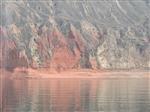
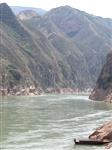
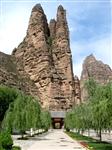
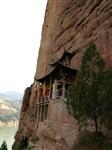
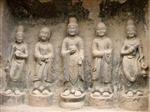
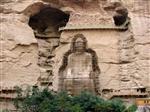
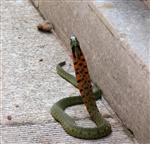
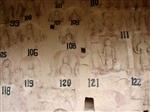

 Copyright © 1998-2025 All rights reserved.
Copyright © 1998-2025 All rights reserved.
1.
May 19, 2012 19:54 Reply
Mr.SCANLON from USA said:
My wife, blond six year old grandson (who speaks Chinese) and I rented a car and driver in Lanzou. We arranged the tour through the Son Hotel were we were staying The trip/adventure was 2 hours through rural working China. REAL CHINA! Then the fascinating boat ride to the caves that were not what we expected....but then the trip made up for the effort. The facilities were "Chinese" ergo and adventure. The people were friendly,honest, financially poor human beings trying to make a buck. A wonderful experience! We went back to China last year.